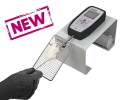Authors
A Dubinski, M Gagné, S Peyrard et al
Lab
Department of Neurosciences, Universite de Montreal, Montreal, QC, Canada
Journal
Human Molecular Genetics
Abstract
Responding effectively to external stress is crucial for neurons. Defective stress granule dynamics has been hypothesized as one of the pathways that renders motor neurons in amyotrophic lateral sclerosis (ALS) more prone to early death. Specifically, it is thought that stress granules seed the cytoplasmic TDP-43 inclusions that are observed in the neurons of most ALS patients, as well as ~50% of all frontotemporal dementia (FTD) patients. In this study, we tested this hypothesis in an intact mammalian nervous system. We established an in vivo heat stress paradigm in mice that effectively triggers the eIF2α pathway and the formation of stress granules in the CNS. In non-transgenic mice, we report an age-dependent decline in the formation of heat-induced stress granules, with 18-month-old animals showing a significant impairment. Furthermore, although neuronal stress granules were robustly observed in non-transgenic mice and SOD1G93A mice, they were largely absent in age-matched TDP-43M337V animals. The observed defect in stress granule formation in TDP-43M337V mice correlated with deficits in expression of key protein components typically required for phase separation. Lastly, while TDP-43 was not localized to stress granules, we observed complete nuclear depletion of TDP-43 in a subset of neurons, with the highest proportion being in the TDP-43M337V mice. Overall, our results indicate that mutant TDP-43 expression is associated with defective stress granule assembly and increased TDP-43 nuclear depletion in the mammalian nervous system, which could be relevant to ALS/FTD pathogenesis.
BIOSEB Instruments Used:
Grip strength test (BIO-GS3)

 Pain - Thermal Allodynia / Hyperalgesia
Pain - Thermal Allodynia / Hyperalgesia Pain - Spontaneous Pain - Postural Deficit
Pain - Spontaneous Pain - Postural Deficit Pain - Mechanical Allodynia / Hyperalgesia
Pain - Mechanical Allodynia / Hyperalgesia Learning/Memory - Attention - Addiction
Learning/Memory - Attention - Addiction Physiology & Respiratory Research
Physiology & Respiratory Research
 Pain
Pain Central Nervous System (CNS)
Central Nervous System (CNS) Neurodegeneration
Neurodegeneration Sensory system
Sensory system Motor control
Motor control Mood Disorders
Mood Disorders Other disorders
Other disorders Muscular system
Muscular system Joints
Joints Metabolism
Metabolism Cross-disciplinary subjects
Cross-disciplinary subjects Preclinical studies and opioids: role in crisis management in the United States
Preclinical studies and opioids: role in crisis management in the United States 